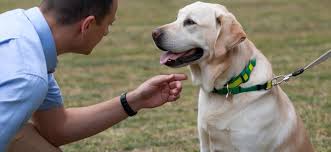
Introduction
When you bring a Labrador into your life, you’re welcoming a loyal, affectionate, and highly intelligent companion. However, without proper training, even the sweetest Labrador can develop problematic behaviors. That’s why obedience training isn’t just a nice-to-have—it’s a must.
Think about it: a well-trained Labrador can safely accompany you on walks, interact politely with guests, and respond instantly in emergencies. Whether you’ve just brought home a playful puppy or are working with an adult Lab, obedience training lays the foundation for a happy and harmonious life together.
Besides, Labradors thrive when they have clear boundaries and expectations. Their eagerness to please and quick learning ability make them ideal candidates for training. In this article, we’ll explore the top 10 obedience commands every Labrador should know—and how you can teach them effectively. Ready to transform your Lab into a model canine citizen? Let’s dive in!
Understanding Labrador Temperament
Before you jump into training, it’s crucial to understand what makes Labradors tick. Known for their friendly and outgoing personalities, Labs are also energetic, playful, and sometimes a bit too enthusiastic. This combination of traits can make training both rewarding and occasionally challenging.
Here are some key temperament traits of Labradors:
- Sociability: They love people and other animals. This can be both a blessing and a distraction during training.
- High energy: Labradors were bred to be working dogs. Without sufficient physical and mental stimulation, they can become bored—and destructive.
- Eagerness to please: This is perhaps the most useful trait for training. Labs are motivated by praise and rewards, which makes them quick learners.
- Food motivation: Let’s be honest—most Labradors are obsessed with food. This can be a great advantage when using treat-based training.
Understanding these traits allows you to tailor your training methods. For instance, using play and treats as rewards works wonders with Labs. On the flip side, you’ll need to account for their distractibility, especially in stimulating environments.
Training should always be positive, consistent, and fun. Harsh methods will only damage trust and undermine your efforts. Instead, leverage your Lab’s natural strengths to create an enjoyable training experience.
Preparing for Obedience Training
Jumping into training without preparation is like trying to bake a cake without reading the recipe. To set yourself and your Labrador up for success, here are some essential steps to take before starting formal training:
Setting Realistic Goals
Every Labrador is unique. Some pick up commands in days, while others need weeks of practice. Set realistic goals based on your dog’s age, temperament, and prior experience. For example:
- Young puppies: Focus on short, basic sessions with simple commands.
- Adolescents: Work on impulse control and gradually build on basic commands.
- Adults: Reinforce existing skills and introduce new ones as needed.
Creating a Positive Training Environment
Your training space should be calm, distraction-free, and safe. Start indoors where you can control the environment, then gradually introduce distractions once your Lab has mastered the basics.
A few tips:
- Keep sessions short (5-10 minutes) to prevent boredom.
- End each session on a positive note with praise or play.
- Avoid training when your Lab is overly tired or too wound up.
Choosing the Right Rewards
Rewards are the engine that drives learning. Since Labradors are famously food-motivated, treats are usually the most effective training tool. However, don’t rely solely on food. Mix in praise, petting, and play to keep your Lab engaged.
When using treats:
- Choose small, soft, high-value treats that your Lab loves.
- Use a variety to maintain interest.
- Gradually reduce treat frequency as your Lab masters a command.
With the right mindset and preparation, you’re now ready to dive into teaching the top obedience commands every Labrador should know.
The Importance of Consistency in Training
Consistency is the secret sauce of effective dog training. Without it, even the most intelligent Labrador will struggle to understand what’s expected. Think of consistency as building a bridge of communication between you and your dog.
Here’s why it matters:
- Clarity: Consistent cues and rewards help your Lab understand exactly what you want.
- Confidence: Predictable outcomes build your dog’s confidence and trust in you.
- Reinforcement: Regular practice solidifies learning and prevents regression.
Tips for Maintaining Consistency
- Use the same words and gestures: If you say “Come here” one day and “Come now” the next, your Lab may get confused. Stick with one command word and a consistent hand signal.
- Everyone must be on board: All family members should use the same commands and training approach. Mixed messages will only confuse your dog.
- Reinforce everywhere: Practice commands in various environments—at home, in the yard, on walks—to help your Lab generalize the behavior.
- Don’t reward bad behavior: If your Lab jumps on you and you respond by petting them, you’re inadvertently reinforcing the jumping.
- Be patient: Consistency requires patience. Celebrate small wins and remember that progress isn’t always linear.
By maintaining consistency, you’re giving your Labrador the best chance to succeed. Now, let’s move on to the first essential command your Lab should master.
Command #1: Sit
“Sit” is often the first command taught—and for good reason. It’s a foundation behavior that helps your Labrador learn impulse control and focus. Plus, it’s incredibly practical. Whether you’re greeting guests, crossing the street, or preparing your Lab’s dinner, a reliable “Sit” makes life easier.
How to Teach Your Labrador to Sit
- Get your Lab’s attention: Hold a treat close to their nose.
- Lure into position: Slowly move the treat upward and backward over their head. As their nose follows the treat, their bottom will naturally lower to the ground.
- Mark and reward: The moment your Lab’s bottom hits the floor, say “Yes!” or click your clicker, then give the treat.
- Add the cue: Once your Lab is consistently following the lure, start saying “Sit” just before moving the treat.
- Practice and fade the lure: Gradually reduce your reliance on the treat to encourage independent response to the verbal cue.

Common Mistakes to Avoid
- Repeating the cue: Saying “Sit, sit, sit” teaches your Lab to wait for multiple cues. Say it once and wait.
- Rushing: Give your Lab time to think and respond. Avoid pushing them into position.
- Inconsistent rewards: In the beginning, reward every successful sit. Once the behavior is strong, you can use variable reinforcement.
With consistent practice, your Labrador will soon sit on cue—even when distractions are present. Ready for the next command?
Command #2: Stay
If “Sit” is the foundation, “Stay” is the glue that holds obedience together. Teaching your Labrador to stay in one place despite distractions builds impulse control, patience, and safety. Imagine your Lab waiting calmly while you answer the door or keeping still at a busy crosswalk—that’s the power of a solid “Stay.”
Teaching Patience with the “Stay” Command
- Start in a quiet space: Begin with your Labrador in a “Sit” or “Down” position.
- Introduce the cue: Hold your hand out like a stop sign and say “Stay” in a calm, clear voice.
- Take a brief step back: Initially, take just one step back. If your Lab holds the position, mark the behavior (“Yes!” or click) and return to reward.
- Gradually build duration: Increase the time your Lab stays in place before returning to reward. Start with 1-2 seconds and build from there.
- Increase distance and distractions: As your Lab progresses, practice moving farther away and introducing mild distractions.
Gradual Distance and Duration Training
Building distance and duration is like adding weights to a gym workout—you must progress gradually to avoid overwhelming your dog.
- Duration: Focus on building the length of time your Lab can stay first. Once they can hold a position for 10–20 seconds, start working on distance.
- Distance: Move further away in small increments. If your Lab breaks the stay, reduce the distance and reinforce success.
- Distractions: Add challenges slowly. Start with simple distractions like walking around the room, then progress to more complex ones like toys or other pets.
Common Pitfalls
- Advancing too quickly: Rushing distance or distractions too soon leads to failure.
- Inconsistent release: Always use a clear release cue like “Okay” or “Free” so your Lab knows when the stay ends.
- Overusing the command: Don’t make your Lab stay for unrealistic periods—short, successful stays are better than long, failed ones.
By practicing patience and building success gradually, you’ll teach your Labrador a life-saving command they can perform anywhere.
Command #3: Come
Imagine this: your Labrador is off-leash at the park, and they spot a squirrel. Without a rock-solid recall, they’re gone in a flash. That’s why “Come” may be the single most important command you teach your Lab.
A reliable recall can save your dog’s life and give you peace of mind. However, it takes time, practice, and lots of positive reinforcement.
How to Train a Reliable Recall
- Start indoors: Begin in a distraction-free environment.
- Use a happy tone: Call your Lab with a cheerful “Come!” while clapping your hands or crouching down.
- Reward generously: When your Lab comes to you, offer high-value treats, praise, and play. Make it the best thing ever!
- Practice short distances: Start by calling your Lab from a few feet away and gradually increase the distance.
- Add the cue: Once your Lab is moving toward you reliably, begin using the “Come” cue consistently.
Overcoming Common Challenges with Recall
- Don’t punish after recall: Never scold your Lab for coming to you, even if they took their time. You want them to associate coming to you with good things.
- Avoid overuse: If you constantly call your Lab for negative experiences (like ending playtime), they’ll ignore the cue. Balance recall practice with positive outcomes.
- Practice with distractions: Gradually introduce real-world distractions so your Lab learns to come when called in any situation.
- Use long lines: When transitioning to outdoor recall training, use a long leash (15–30 feet) to maintain control while allowing freedom.
Building a strong recall takes time, but it’s worth every second. Consistent, positive practice ensures your Labrador will come running no matter what.
Command #4: Down
“Down” is another versatile command that promotes calm behavior and self-control. Teaching your Labrador to lie down on cue is useful for managing energy, promoting relaxation, and creating polite behavior in public settings.
Step-by-Step Guide to Teaching “Down”
- Start in a “Sit” position: Have your Labrador sitting and focused on you.
- Lure to the ground: Hold a treat in your hand near your Lab’s nose and slowly lower it to the floor between their paws. Move the treat forward slightly to encourage them to lie down.
- Mark and reward: As soon as your Lab’s elbows touch the ground, mark the behavior (“Yes!” or click) and reward.
- Add the cue: Once your Labrador is reliably following the lure, introduce the verbal cue “Down” just before lowering the treat.
- Practice and fade the lure: Gradually reduce your reliance on the treat, rewarding your Lab for responding to the verbal cue alone.
Reinforcing Calm Behavior
Teaching “Down” isn’t just about obedience—it’s a powerful tool for promoting relaxation and impulse control. Once your Lab understands the command, use it in the following ways:
- Settle at home: Teach your Lab to lie down calmly during meals or when guests visit.
- Public outings: Use “Down” in pet-friendly stores, cafes, or outdoor seating areas to encourage calm behavior.
- Managing excitement: If your Labrador is overly excited, cueing a “Down” can help them reset and relax.
Common Mistakes
- Forcing the position: Never push your Lab into a down position. It creates resistance and damages trust.
- Skipping rewards: In the early stages, reward every successful down to build enthusiasm for the behavior.
- Lack of practice: Like any command, “Down” requires regular practice to maintain reliability.
Mastering “Down” empowers you to help your Labrador manage their energy and behavior in any situation.
Command #5: Leave It
“Leave It” is one of the most crucial safety commands you can teach your Labrador. Whether it’s a dropped medication pill, a tempting piece of food, or something hazardous on a walk, “Leave It” can prevent dangerous situations in an instant.
Why “Leave It” Is Crucial for Safety
Labradors are naturally curious and food-driven. Without a solid “Leave It,” they’re likely to investigate or ingest things they shouldn’t. A well-trained “Leave It” can:
- Prevent poisoning from harmful substances
- Stop scavenging behavior during walks
- Protect your belongings from curious jaws
Practical Exercises for Mastering This Command
- Start with a covered treat: Place a treat under your hand on the floor.
- Say “Leave It”: When your Lab tries to sniff or paw at your hand, calmly say “Leave It.”
- Wait for disengagement: The moment your Lab backs away or looks at you, mark the behavior and reward with a different treat (not the covered one).
- Progress to uncovered treats: Once your Lab understands the concept, practice with visible treats, increasing the difficulty over time.
- Generalize the behavior: Practice “Leave It” with toys, objects on the ground, and eventually in real-life scenarios during walks.
Tips for Success
- Be patient: “Leave It” takes time to master, especially for food-loving Labradors.
- Use high-value rewards: Make sure the reward for leaving the item is worth it!
- Practice regularly: Like all safety commands, “Leave It” should be maintained through ongoing practice.
A rock-solid “Leave It” gives you peace of mind and keeps your Labrador safe in an unpredictable world.


